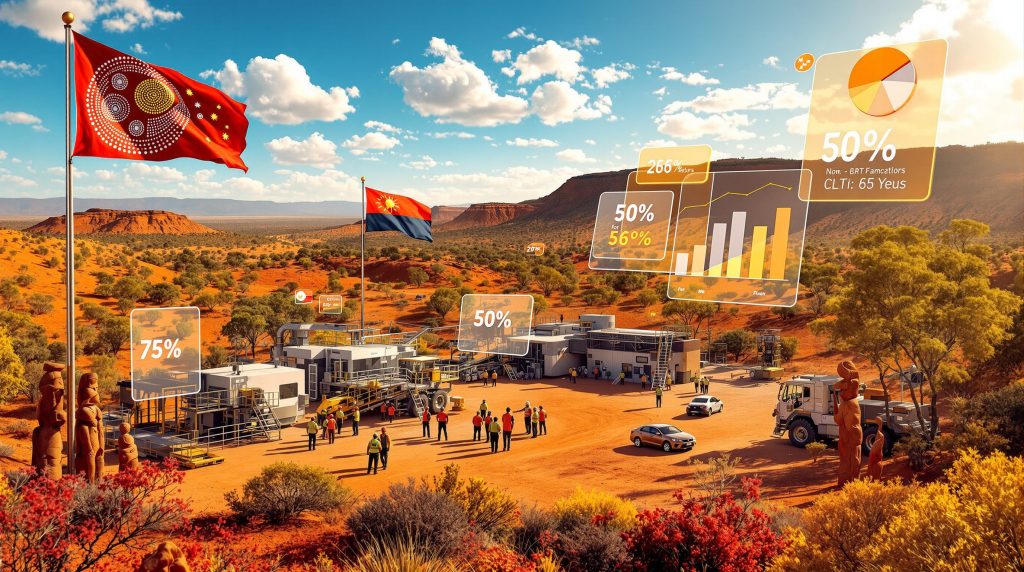## Understanding Indigenous Mining Partnerships in Modern Australia
Indigenous mining partnerships represent collaborative frameworks where Aboriginal and Torres Strait Islander communities engage as active stakeholders in resource development projects. Furthermore, the industry is witnessing significant mining industry evolution that is reshaping collaboration models.
Recent industry developments highlight the evolving nature of these arrangements. At the Aboriginal Enterprises in Mining, Energy and Exploration conference in Darwin during November 2025, Matt Denyer, a Gomeroi man and principal adviser of Indigenous partnerships and communities at the Minerals Council of Australia, emphasised that Indigenous businesses stand at a critical crossroads. He argued that the resources industry must lean in with partnerships, investments, and other opportunities.
## Why Traditional Procurement Models Fall Short of True Partnership
Current procurement frameworks, while generating substantial Indigenous business revenue, create dependency rather than independence. Australia's Indigenous business procurement reached $5.83 billion in 2024-25, with mining contributing $1.64 billion and representing 28% of the national total. However, transactional relationships lack the transformative power of genuine ownership structures.
The distinction between participation and power is clear when examining Australia's mining landscape. Only one mine operation is Indigenous-led, with no Indigenous-owned processing facilities or significant Indigenous capital investment in mining ventures. Consequently, the resource value flows through communities via contracts, while long-term benefits move elsewhere.
## What Does Genuine Indigenous Equity Look Like in Mining?
Genuine Indigenous equity participation involves ownership stakes that grant voting rights, profit sharing, board representation, and strategic influence over project development. These arrangements typically offer direct equity stakes ranging from 5-20%—depending on the project scale and negotiation outcomes.
### Direct Equity Structures
Direct ownership models provide Indigenous communities with:
• Proportional voting rights aligned with ownership share
• Dividend distributions based on operational profitability
• Board seat allocation ensuring governance representation
• Strategic decision influence over major operational changes
• Capital appreciation benefits through asset value growth
### Joint Venture Arrangements
Collaborative structures position Indigenous entities as co-developers rather than mere service providers. In addition, these partnerships share both capital requirements and operational responsibility over project lifecycles that span from 5 to more than 20 years.
### Infrastructure Ownership Models
Indigenous groups may also develop and own critical mining infrastructure. This creates revenue streams extending beyond individual project lifespans. The approaches include:
• Processing facility ownership generating operational fees and profit participation
• Transportation network control for rail and port facilities
• Service operations management of power generation and water treatment
• Technology platform development supporting multiple mining operations
## How Do Revenue Sharing Mechanisms Work in Practice?
Revenue sharing arrangements typically operate through tiered percentage systems that balance Indigenous community benefits with project economics. These mechanisms are structured with various calculation methods based on revenue thresholds and operational characteristics.
### Tiered Distribution Framework
| Revenue Threshold | Indigenous Share | Application Method |
|---|---|---|
| First $100M annually | 3-5% | Gross revenue basis |
| $100M-$500M annually | 2-4% | Net profit basis |
| Above $500M annually | 1-3% | Adjusted EBITDA basis |
For instance, the Gross Revenue Basis applies to lower thresholds by calculating payments on total revenue regardless of production costs. This method provides Indigenous communities with earnings certainty during project start-up phases, although it is less sensitive to operational improvements.
At mid-range thresholds, the Net Profit Basis is used after deducting operational costs, including labour and materials. Consequently, this aligns Indigenous interests with efficiency while encouraging strict cost management.
The Adjusted EBITDA Basis focuses on high-revenue operations. It measures earnings before interest, taxes, depreciation, and amortisation, reducing the impact of varied capital structures.
### Long-term Value Creation Mechanisms
Successful revenue sharing arrangements establish sustainable models that include:
• Intergenerational wealth funds to create permanent community endowments
• Education and training endowments that support workforce development
• Community infrastructure development funding essential services
• Cultural preservation initiatives to maintain traditional practices and knowledge
## What Role Does Employment and Business Development Play?
Employment and business development are critical in comprehensive Indigenous partnerships. These elements extend well beyond traditional hiring practices by supporting career development, enterprise creation, and long-term economic capacity building.
### Indigenous Workforce Development Strategies
Mining companies with strong Indigenous engagement often achieve significantly higher Indigenous workforce participation rates. Such programmes include:
• Leadership development programmes aimed at advancing Indigenous careers into senior roles
• Apprenticeship and traineeship programmes aligned with industry certification requirements
• Cultural competency training for non-Indigenous staff
• Mentorship structures pairing experienced professionals with emerging Indigenous talent
Furthermore, some companies employ capital raising methods to fund partnership projects effectively.
### Indigenous Business Enterprise Development
Partnership frameworks actively foster Indigenous business capacity through structured measures. For example, preferential contracting policies may require:
• Mandatory participation requirements ranging from 10-30% of total contract value
• Joint venture pairings between Indigenous and established contractors
• Capacity building support so that Indigenous businesses can gradually win larger contracts
• Performance bonding assistance to access critical financial instruments
In addition, these frameworks enhance supply chain integration by establishing:
• Long-term supply agreements that extend beyond annual cycles
• Technical assistance programmes offering specialised training
• Capital access facilitation connecting Indigenous enterprises with funding opportunities
• Quality certification support to meet industry standards
For instance, successful programmes have led to increased junior mining investments in community-led projects.
## How Do Cultural and Environmental Considerations Shape Collaborations?
Cultural and environmental considerations are fundamental in shaping Indigenous collaborations. These elements require the integration of traditional knowledge systems with contemporary mining practices. They go beyond mere regulatory compliance to include traditional ecological management, sacred site protection, and community-controlled stewardship.
### Traditional Knowledge Integration
Effective partnerships integrate traditional ecological knowledge through:
• Environmental monitoring programmes that use both traditional and scientific indicators
• Cultural heritage protection protocols for safeguarding sacred sites
• Traditional land management practices in mine rehabilitation and closure planning
• Biodiversity conservation initiatives based on traditional species management techniques
At the same time, innovative mine reclamation innovation approaches incorporate traditional practices with modern techniques.
### Free, Prior, and Informed Consent Implementation
Genuine collaborations require comprehensive FPIC implementation. During the pre-project phase, communities engage in:
• Baseline consultation to understand proposed operations
• Identification of traditional owners following cultural protocols
• Impact assessments that incorporate cultural, spiritual, and environmental dimensions
• Decision-making processes that respect traditional governance structures
Operationally, this includes:
• Ongoing consultation via community committees and liaison officers
• Real-time impact monitoring with community participation
• Amendment procedures for changes affecting traditions
• Veto mechanisms for significant cultural or environmental impacts
### Environmental Stewardship Models
Partnership-based environmental management integrates:
• Indigenous-led monitoring programmes that combine traditional and scientific measures
• Traditional burning practices in fire management and land rehabilitation
• Water resource protection protocols that honour traditional uses
• Cultural landscape preservation to maintain community connections to traditional territories
## What Are the Current Challenges Facing Indigenous Partnerships?
Indigenous partnerships face significant challenges that limit their development and effectiveness. Many communities encounter capacity constraints and power imbalances during negotiations, while regulatory frameworks lag behind best practices.
### Capacity and Resource Constraints
Many Indigenous communities face limitations due to:
• Restricted access to technical expertise for complex project evaluation
• Limited legal and financial advisory resources for partnership agreements
• Project management difficulties in handling large-scale operations
• Insufficient capital availability for substantive equity participation
The landscape is stark. With only one Indigenous-led mine operation, no Indigenous-owned processing facilities, and no significant Indigenous capital funds, these structural barriers remain formidable.
### Power Imbalances in Negotiations
Structural challenges create unequal negotiating positions:
• Information asymmetries between communities and mining companies
• Limited Indigenous representation in senior industry roles
• Inadequate government support for capacity building
• Time pressures that force expedited rather than comprehensive agreements
### Implementation and Enforcement Issues
Even well-structured partnerships encounter operational issues:
• Inconsistent interpretation of agreement terms
• Limited dispute resolution mechanisms for Indigenous contexts
• Inadequate monitoring systems for tracking benefits
• Insufficient penalties for companies that fail commitments
### Economic Integration Barriers
Systematic barriers hinder economic integration, such as:
• Restricted access to capital markets for growth funding
• Regulatory complexity around Indigenous business structures
• Skills gaps in technical mining areas
• Geographic isolation impacting service delivery and development support
## How Can the Industry Scale Indigenous Collaborations?
Scaling Indigenous collaborations requires coordinated efforts across policies, industry standards, and financial innovation. Systematic changes must address structural barriers while creating incentives for genuine partnerships.
### Policy Framework Development
Government initiatives should establish:
• Mandatory partnership requirements for major projects
• Tax incentives for companies practising genuine equity sharing
• Funding support programmes for technical, legal, and business capacity building
• Standardised assessment criteria to gauge partnership success
In addition, governments should consider indigenous collaboration policies to support these initiatives.
### Industry-Wide Standards
Mining sector initiatives must create:
• Minimum equity participation thresholds as baseline criteria
• Best practice guidelines for negotiation, implementation, and monitoring
• Peer review and certification processes that ensure quality
• Annual reporting requirements that provide transparency on community benefits
### Financial Innovation
New funding mechanisms could support partnerships through:
• Indigenous equity participation loans for community investments
• Risk-sharing arrangements to reduce investment barriers
• Indigenous-focused mining investment funds to pool capital
• Blended finance structures combining public and private resources
### Technology and Knowledge Transfer
Digital technologies can enhance partnership effectiveness by offering:
• Transparent benefit tracking systems with real-time revenue visibility
• Environmental monitoring platforms integrating traditional and scientific data
• Cultural heritage mapping tools that protect significant sites
• Remote training programmes for expanding technical education
## What Does Success Look Like for Indigenous Mining?
Successful mining ventures generate measurable benefits across economic, social, and cultural dimensions. They deliver sustainable advantages that extend well beyond immediate project timelines.
Quantitative success metrics include:
• Equity participation rates in major projects
• Business revenue growth beyond traditional procurement
• Employment advancement for Indigenous professionals
• Community development indicators in education, health, and infrastructure
Qualitatively, success is seen in:
• Enhanced community self-determination through real decision-making power
• Effective cultural heritage protection that maintains spiritual connections
• Integrated environmental stewardship combining traditional knowledge with modern practices
• Intergenerational benefit distribution that secures long-term community prosperity
Furthermore, an industry commitment is evident when Indigenous stakeholders help drive project development. Truly, Indigenous mining partnerships drive long-term success.
## Future Outlook: Building Sustainable Indigenous Ventures
The future of Indigenous ventures will be shaped by emerging opportunities in critical minerals, technological innovations, and evolving regulations. New partnership models are already taking shape, addressing current structural limitations.
Emerging opportunities include:
• Critical minerals extraction for battery technologies with Indigenous communities as key stakeholders
• Rare earth element processing facilities on Indigenous lands
• Renewable energy infrastructure development combining mining with solar and wind projects
• Carbon credit programmes that integrate traditional land management practices
Digital technologies will further enhance partnership effectiveness through:
• Blockchain-based benefit sharing for transparent, automated revenue distribution
• Artificial intelligence applications in environmental monitoring
• Remote sensing for blending traditional knowledge with modern land management
• Digital training platforms for expanding technical skills
Moreover, future regulatory frameworks may require:
• Enhanced FPIC standards aligned with international best practices
• Mandatory monitoring of community benefits and partnership outcomes
• Optimised tax frameworks that support Indigenous business development
• Robust dispute resolution mechanisms specifically for these collaborations
Ultimately, Indigenous mining partnerships are the key to future progress. Australian partnerships can learn from international models while respecting local Indigenous rights. Successful examples from Canada, Scandinavia, Papua New Guinea, and Namibia highlight transformative strategies that ensure both economic independence and cultural preservation.
Disclaimer: This analysis presents general information about Indigenous mining collaborations and should not be considered investment advice or legal guidance. Outcomes depend on multiple factors including commodity prices, regulatory changes, and specific agreement terms. Readers are encouraged to seek professional advice before making business decisions related to mining partnerships.
Interested in Identifying the Next Major Mineral Discovery?
Discovery Alert's proprietary Discovery IQ model delivers instant notifications when significant ASX mineral discoveries are announced, transforming complex geological data into actionable trading opportunities. Explore how historic discoveries have delivered substantial returns and begin your 30-day free trial today to position yourself ahead of the market.




